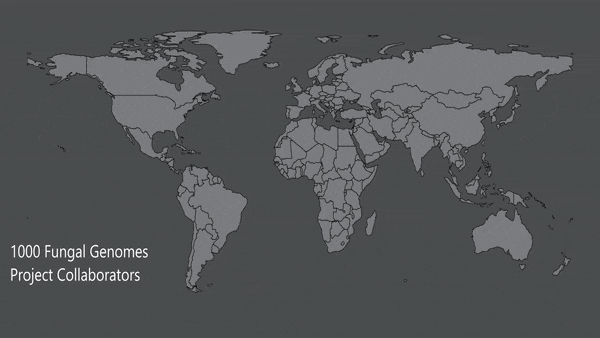2022 marks the JGI’s 25th anniversary. Over the last year, we’ve been revisiting a number of notable achievements that showcase our collaborations and capabilities to enable great science that will help solve energy and environmental challenges.
Over the last two-and-a-half decades, the JGI has been facilitating the creation, growth and expansion of research communities by producing and sharing high-quality genomes. As our data portals grow and evolve, the research communities further expand around them. Two large scale projects have taken a different approach, with communities forming to generate high quality genomes to benefit researchers around the world.
As a U.S. Department of Energy Office of Science User Facility, the JGI holds team science and collaboration as core values to the work we do. Our commitment to public data has provided the opportunity to bring together researchers and stakeholder agencies from around the globe to build and share genomics knowledge.

The 1KFG project represents affiliations at over 180 organizations in 29 U.S. states and 35 countries. (Graphic: Neil Byers)
The JGI launched the 1000 Fungal Genomes (1KFG) Project through a 2012 Community Science Program proposal. Joseph Spatafora of Oregon State University led the effort to sequence 1000 fungal genomes to create two reference genomes for all fungi families — essentially, the foundation for an encyclopedia of reference genomes for fungal metagenomics.
Two more CSP proposals came in 2016 that would complement these initial efforts: Spatafora and Jason Stajich from UC Riverside would focus on broad sampling of early diverging fungi, and Francis Martin of the French National Institute for Agricultural Research (INRAE) focused on in-depth exploration of ecology-related groups of fungi.
The 1KFG project has brought together over 400 proposal collaborators and co-authors with affiliations at over 180 organizations in 29 U.S. states and 35 countries. Of the 85 proposal collaborators, 58 had never shared a proposal with each other prior to their involvement with the 1KFG project.
Over 1,000 species have been nominated for the project by more than 100 participants. Roughly 700 have been sequenced and annotated, representing 384 fungal families with at least two genomes, and another 190 families with one. There are another 100 genomes in progress and 200 that are pending samples from users. Roughly 300 have been published.
Spatafora said the work has “significantly advanced our understanding of 1 billion years of evolution in Kingdom Fungi — from phylogenetic relationships to evolution of genomic mechanisms — resulting in the diversity of fungal phenotypes and a myriad of ecologies.”
The Open Green Genomes Initiative is the product of a 2018 Community Science Program proposal from James Leebens-Mack of the University of Georgia, along with 100 of his colleagues in the comparative plant genomics community. The project’s aim is to generate high-quality genome assemblies and annotations for 35 species representing all major evolutionary lineages in the land plant tree of life.
As of the start of 2022, there were 120 principal investigators involved in the Open Green Genomes project.
“We currently have 19 genomes sequenced, 15 that are in sequencing or assembly right now, and eight more that we are likely to take forward with material in hand,” said Jeremy Schmutz, lead of the JGI’s Plant Program, including genomes that are both large and complex.
The first publication of a genome generated by the OGG initiative — for Ceratopteris richardii, or C-fern — came out in the September issue of Nature Plants. C-fern has a genome approximately three times the size of the human genome. There are four more fern genomes in progress.
One unique aspect of this project is its focus on wild species as opposed to crop plants. Because crop plants have been manipulated over time by humans, they tend to have unusual genomes.
“The OGG plants provide a true view of evolutionary-derived genomes,” Schmutz explained. “…They provide a more straightforward way to connect genes and infer changes in gene function across the phylogeny — and link these into our DOE crop plants, so we can learn from evolution that has occurred throughout plant history.”
Related Links:
- 1000 Fungal Genome project on MycoCosm
- JGI Science Highlight: Computationally Classifying Fungal Lifestyles
- JGI Science Highlight: Model fern reveals insight into DNA thievery in ferns
- JGI Genome Insider podcast: Filling in the Plant Tree of Life